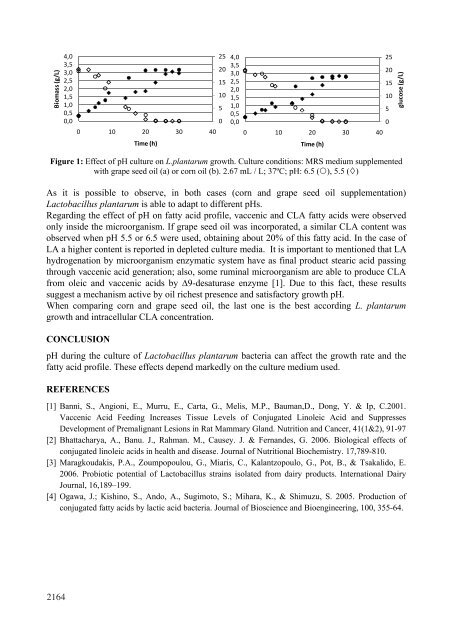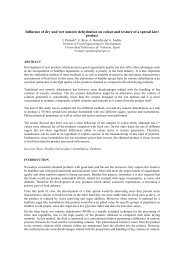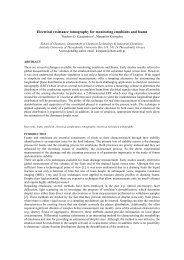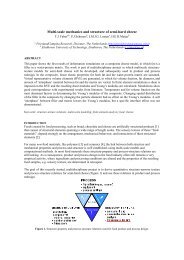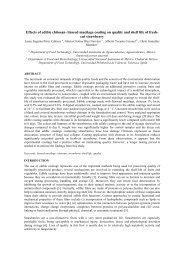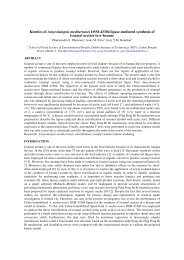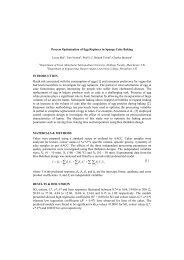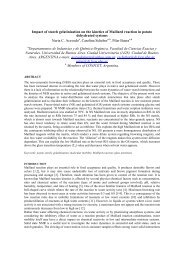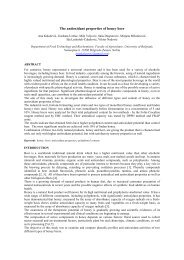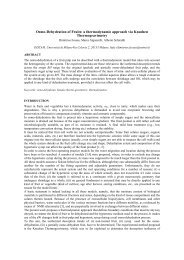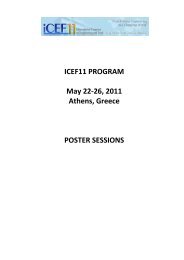- Page 1 and 2:
1th International Congres on Engine
- Page 4 and 5:
FOOD PROCESS ENGINEERING IN A CHANG
- Page 6:
ICEF11 ORGANIZERS Organizer: Nation
- Page 9 and 10:
Rao, Anandha (Andy) Raspor, Peter R
- Page 12 and 13:
ACKNOWLEDGEMENTS The 11 th Internat
- Page 14 and 15:
PREFACE The present book is part of
- Page 16 and 17:
Emerging technologies CONTENTS-VOLU
- Page 18 and 19:
Effect of ultra high pressure homog
- Page 20 and 21:
Bioprocessing engineering Character
- Page 22 and 23:
Rapid HPTLC-based method for qualit
- Page 24 and 25:
Effect of contamination stage and i
- Page 26 and 27:
Furan derivatives dynamic in rye br
- Page 28 and 29:
Manufacture of gelatin-based films
- Page 30 and 31:
Mechanical processing of foods Stud
- Page 32 and 33:
11th International Congress on Engi
- Page 34 and 35:
Production of Turkish delight (loku
- Page 36 and 37:
Effect of different ratios of malto
- Page 38 and 39:
HIGHTECH EUROPE PROJECT WORKSHOP OP
- Page 40:
The potential for superchilling to
- Page 43 and 44:
Table 1. mass transfer results for
- Page 45 and 46:
as 37% at 40g/l, 2.0MPa TMP and 30
- Page 47 and 48:
and OAA of the bun decreased with i
- Page 49 and 50:
temperature profile when applying a
- Page 51 and 52:
Figure 1 compared the PSD patterns
- Page 53 and 54:
Table 1. Results of the EF treatmen
- Page 55 and 56:
VI solution in combination with the
- Page 57 and 58:
RESULTS & DISCUSSION Fig. 1 present
- Page 59 and 60:
RESULTS & DISCUSSION The impact of
- Page 61 and 62:
seemed to be less effective on TVC
- Page 63 and 64:
presence of colored compounds and p
- Page 65 and 66:
PCA model to identify fresh and fro
- Page 67 and 68:
The concentration of vitamin C was
- Page 69 and 70:
denoting that these tissues became
- Page 71 and 72:
egime, presents a concave curve sha
- Page 73 and 74:
encapsulation by Spray Gun was 2.40
- Page 75 and 76:
studying the squid protein concentr
- Page 77 and 78:
Since treatment at maximum voltage
- Page 79 and 80:
educed to 22,5% in comparison to un
- Page 81 and 82:
material (unprocessed carrot). None
- Page 83 and 84:
them barely visible at the optical
- Page 85 and 86:
peak viscosity over control was obs
- Page 87 and 88:
model of enzymes inactivation. The
- Page 89 and 90:
values than controls. A significant
- Page 91 and 92:
G'(Pa) 100 90 80 70 60 50 40 30 20
- Page 93 and 94:
Viscosity (mPa.s) 7 6 5 2 0 10 20 3
- Page 95 and 96:
The previous thermal germination of
- Page 97 and 98:
activity. Recent results have been
- Page 99 and 100:
Jam preparation and methods for the
- Page 101 and 102:
The size of the ice crystals in gel
- Page 103 and 104:
volatile constituents are the sesqu
- Page 105 and 106:
at 300 and 400 MPa (D = 1.99 and 0.
- Page 107 and 108:
of the fact that some enzymes canno
- Page 109 and 110:
Table 1: Effect of high pressure hy
- Page 111 and 112:
contrast, in samples treated at 300
- Page 113 and 114:
It was found that HP-tofu, using th
- Page 115 and 116:
amount of quercetin that was infuse
- Page 117 and 118:
[]*10 -3 (deg.cm 2 .dmol -1 ) 10 0
- Page 119 and 120:
which no culture management is nece
- Page 121 and 122:
Rheological measurements were carri
- Page 123 and 124:
1690
- Page 125 and 126:
Yield (%) 80 70 60 50 40 30 20 10 0
- Page 127 and 128:
corresponding to antagonism (the ef
- Page 129 and 130:
Also the separation efficiency has
- Page 131 and 132:
as an in vitro study on the colon c
- Page 133 and 134:
BSA, trypsin, and pepsin were selec
- Page 135 and 136:
proposed by Apelblat can describe t
- Page 137 and 138:
potassium phosphate salts confer di
- Page 139 and 140:
Figure 1. Effect of pH and NaPA con
- Page 141 and 142:
subsequently temperature maintained
- Page 143 and 144:
could increase the viscosity of the
- Page 145 and 146:
eductions. Taking availability and
- Page 147 and 148:
Liquid Chromatography Coupled to Is
- Page 149 and 150:
and a 5.2-fold improvement (average
- Page 151 and 152:
Regarding the solubility of astaxan
- Page 153 and 154:
Figure 1. Cumulative oil yield vers
- Page 155 and 156:
This indicates that all the medium-
- Page 157 and 158:
RESULTS & DISCUSSION In the KCl1 co
- Page 159 and 160:
Furthermore, it was observed that t
- Page 161 and 162:
production of the intermediate limo
- Page 163 and 164:
Table 1. Microbial counts of total
- Page 165 and 166:
Total viable counts remained about
- Page 167 and 168:
Table 1. Mean values of the notes a
- Page 169 and 170:
RESULTS & DISCUSSION The general tr
- Page 171 and 172:
a) b) meq oxígeno/Kg 6 5 4 3 2 1 0
- Page 173 and 174:
According to Figure 1, in glucose m
- Page 175 and 176:
Figure 1. a) Surface plots with eff
- Page 177 and 178:
expressed by the molecular diffusio
- Page 179 and 180:
Effect of dispersed phase volume fr
- Page 181 and 182:
RESULTS & DISCUSSION Figure 1. Expe
- Page 183 and 184:
Oxygen rate transmission (OTR) was
- Page 185 and 186:
outputs and experimental values. It
- Page 187 and 188:
Figure 1: Gallery of corn tortilla
- Page 189 and 190:
esistance to mass transfer takes pl
- Page 191 and 192:
Table 1-Levels of protein fractions
- Page 193 and 194:
Figure 1. Minimum Noise Fraction Tr
- Page 195 and 196:
for 28.6 and 12.6% of the total sam
- Page 197 and 198:
Phenomena related to the movement o
- Page 199 and 200:
order/genus level. In one year appl
- Page 201 and 202:
RESULTS & DISCUSSION No differences
- Page 203 and 204:
RESULTS & DISCUSSION The shelf-life
- Page 205 and 206:
RESULTS & DISCUSSION The spectra of
- Page 207 and 208:
RESULTS & DISCUSSION The results fo
- Page 209 and 210:
factors for the development of shap
- Page 211 and 212:
plates were dipped into a 0.05% DPP
- Page 213 and 214:
esponse of the samples and measurin
- Page 215 and 216:
and median of 0.25 mg/L) in the raw
- Page 217 and 218:
inadequate/poor information about e
- Page 219 and 220:
The joint analysis of these results
- Page 221 and 222:
A study on germination time and myc
- Page 223 and 224:
for decreasing temperature. An incr
- Page 225 and 226:
Table 1. Weibull distribution param
- Page 227 and 228:
Figure 1 shows the contour plots of
- Page 229 and 230:
minute [2]; therefore attached E. c
- Page 231 and 232:
the presence of L-carnitine. At 14
- Page 233 and 234:
The results were obtained over time
- Page 235 and 236:
depends on the temperature. Rather
- Page 237 and 238:
* da * * ka a (1) dt * * 15.08 aa0
- Page 239 and 240:
RESULTS & DISCUSSION Simultaneous c
- Page 241 and 242:
Figure 1. Change of HMF concentrati
- Page 243 and 244:
RESULTS & DISCUSSION Data on remain
- Page 245 and 246:
under sub-optimal conditions, were:
- Page 247 and 248:
Figure 1. Scores Plot for 3 storage
- Page 249 and 250:
modulates thermal inactivation of e
- Page 251 and 252:
conditions, this procedure was isol
- Page 253 and 254:
150-400 CFU/cm 2 ) may still pass t
- Page 255 and 256:
1822
- Page 257 and 258:
theirs hands and arms before milkin
- Page 259 and 260:
Figure 1. HMF reduction of styrene-
- Page 261 and 262:
high respiration rates could be exp
- Page 263 and 264:
6.4-5.5 and aw 0.98 to
- Page 265 and 266:
in Graviera cheese due to reheating
- Page 267 and 268:
RESULTS & DISCUSSION IMF items are
- Page 269 and 270:
implementation in the hospitals. Wi
- Page 271 and 272:
Finally, concerning the water-bottl
- Page 273 and 274:
a high amount of data, enough to es
- Page 275 and 276:
a-T room = 20°C b-T room = 25°C c
- Page 277 and 278:
Table 1. Fillet pH drip loss and le
- Page 279 and 280:
oth temperatures. The rates of putr
- Page 281 and 282:
RESULTS & DISCUSSION The population
- Page 283 and 284:
Until now the declaration has been
- Page 285 and 286:
For the selection of the appropriat
- Page 287 and 288:
RESULTS AND DISCUSSION Volatile com
- Page 289 and 290:
3. Characterisation of protein phys
- Page 291 and 292:
High CA contents were usually accom
- Page 293 and 294:
electric transformer in order to gi
- Page 295 and 296:
icher in compounds from all chemica
- Page 297 and 298:
the pH and temperature changes are
- Page 299 and 300:
may cause 100 times greater risk of
- Page 301 and 302:
RESULTS & DISCUSSION Concerning the
- Page 303 and 304:
Food-serving businesses that wish t
- Page 305 and 306:
CONCLUSION Meat texture and fat con
- Page 307 and 308:
RESULTS & DISCUSSION Irrespective o
- Page 309 and 310:
Table 1. Furan levels in roasted co
- Page 311 and 312:
was verified that furan levels sign
- Page 313 and 314:
The parameter of form (n) varied pr
- Page 315 and 316:
antioxidant capacity of spices extr
- Page 317 and 318:
RESULTS & DISCUSSION DON concentrat
- Page 319 and 320:
Figure 1. Fitted curves of polynomi
- Page 321 and 322:
The equations describing the system
- Page 323 and 324:
RESULTS & DISCUSSION Nine furan der
- Page 325 and 326:
RESULTS & DISCUSSION The mycelia gr
- Page 327 and 328:
REFERENCES [1]. Leung AY. 1978. Enc
- Page 329 and 330:
1896
- Page 331 and 332:
ACKNOWLEDGMENTS These results are p
- Page 333 and 334:
evaporated. It is assumed that the
- Page 335 and 336:
onion tissue was not observed becau
- Page 337 and 338:
temperature. During the first 5 min
- Page 339 and 340:
Pre cooling Filleting Baader 184/18
- Page 341 and 342:
1908
- Page 343 and 344:
700 mm and predominantly Western wi
- Page 345 and 346:
In the beginning of heating, there
- Page 347 and 348:
To investigate the damage of cooked
- Page 349 and 350:
The water activity of the pistachio
- Page 351 and 352:
done. Figure 1 shows the comparison
- Page 353 and 354:
The first results show a variation
- Page 355 and 356:
contrast, the nature of the pan has
- Page 357 and 358:
with 12 sec process holding times y
- Page 359 and 360:
Figure 1. Temperature history of wh
- Page 361 and 362:
heat transfer characteristics. Two
- Page 363 and 364:
espondents of the five (5) schools
- Page 365 and 366:
it was 62.73 (±4.68) ppb for force
- Page 367 and 368:
treatment time and therefore an ene
- Page 369 and 370:
Figure 1 shows the effect of tannin
- Page 371 and 372:
influenced significantly by osmodeh
- Page 373 and 374:
intracellular product extraction. A
- Page 375 and 376:
The textural analysis did not diffe
- Page 377 and 378:
powder. Kumar et al. [1] reported t
- Page 379 and 380:
In all the position of MW3 cases, t
- Page 381 and 382:
ventilation led to significant savi
- Page 383 and 384:
correlation was found between the t
- Page 385 and 386:
tested in this work (0-37 kW/m 3 ).
- Page 387 and 388:
Comparing trials 9 and 10, it is po
- Page 389 and 390:
To study the effect of pH and added
- Page 391 and 392:
Spectronic). Bovine serum albumin w
- Page 393 and 394:
temperature up to 50 °C or even hi
- Page 395 and 396:
(1547 cm -1 ) and amide-III (1239 c
- Page 397 and 398:
The respiration pattern at 0 day fo
- Page 399 and 400:
In the whole grains of wheat and oa
- Page 401 and 402:
eduction verified by Reddy et. al.
- Page 403 and 404:
most flavours, except esters, were
- Page 405 and 406:
anisotropic shrinkage since shrinki
- Page 407 and 408:
Analysis of water activity (a w) Ta
- Page 409 and 410:
year on colour was more important t
- Page 411 and 412:
texture analyzer CT3 (BROOKFIELD, E
- Page 413 and 414:
1980
- Page 415 and 416:
1982
- Page 417 and 418:
was obvious that the higher levels
- Page 419 and 420:
t test not shown)The fitted results
- Page 421 and 422:
RESULTS & DISCUSSION Each fruit pre
- Page 423 and 424:
powder, indicates that during the d
- Page 425 and 426:
(a) (b) Figure 1. Relationship betw
- Page 427 and 428:
RESULTS & DISCUSSION The results sh
- Page 429 and 430:
TA/XT/PLUS-Texture Analyser and the
- Page 431 and 432:
RESULTS & DISCUSSION The results of
- Page 433 and 434:
RESULTS & DISCUSSION The final mois
- Page 435 and 436:
model was their average relative er
- Page 437 and 438:
indicated that the moisture diffusi
- Page 439 and 440:
Figure 1. Vitamin C content for the
- Page 441 and 442:
ehydration with a fast initial wate
- Page 443 and 444:
At this condition, the moisture con
- Page 445 and 446:
RESULTS & DISCUSSION The ENCF treat
- Page 447 and 448:
Table 1. Experiments were scheduled
- Page 449 and 450:
RESULTS & DISCUSSION All volatile c
- Page 451 and 452:
generated by cavitation injured str
- Page 453 and 454:
PA, PB and PC, respectively. The DE
- Page 455 and 456:
Table 1. Resume of results of the d
- Page 457 and 458:
passes without change of phase, and
- Page 459 and 460:
vegetable coagulant alone or a blen
- Page 461 and 462:
esults in a cheese with higher scor
- Page 463 and 464:
RESULTS & DISCUSSION Concerning the
- Page 465 and 466:
chemical properties evaluated. It w
- Page 467 and 468:
Substitution with pea protein isola
- Page 469 and 470:
the fact that aleurone oat layer an
- Page 471 and 472:
RESULTS & DISCUSSION Function of Cr
- Page 473 and 474:
plants. Only freeze-dried lemon bal
- Page 475 and 476:
at promoting homemade preparation o
- Page 477 and 478:
From 200 isolates, 60 isolates rema
- Page 479 and 480:
acid (AA). The juice of San Martin
- Page 481 and 482:
organisation of the thylakoids at t
- Page 483 and 484:
Cáhuil from the Center showed the
- Page 485 and 486:
RESULTS & DISCUSSION Composition of
- Page 487 and 488:
65% Figure 1. Stress-strain curves
- Page 489 and 490:
unique for each sugar. The volume (
- Page 491 and 492:
2058
- Page 493 and 494:
lower foaming capacity but higher s
- Page 495 and 496:
obtained in the flowering period, u
- Page 497 and 498:
The results of physicochemical char
- Page 499 and 500:
Drolet et al. [2] and Løvaas [3],
- Page 501 and 502:
In order to obtain an absorbance va
- Page 503 and 504:
decrease in the water ability due t
- Page 505 and 506:
Table 1. Global yield (X0 % w/w) of
- Page 507 and 508:
Figure 1. Effect of mixing time wit
- Page 509 and 510:
chain. Liquid-holding capacity was
- Page 511 and 512:
Where, is the porosity of the extr
- Page 513 and 514:
RESULTS & DISCUSSION The results sh
- Page 515 and 516:
that showed a higher intensity of t
- Page 517 and 518:
fermented sausages was detected by
- Page 519 and 520:
interval, four aliquots stored in m
- Page 521 and 522:
2.26 ppm) that can be considered as
- Page 523 and 524:
The three controlled factors (VI, p
- Page 525 and 526:
presenting differences in color. Ca
- Page 527 and 528:
The mean composition of ice creams
- Page 529 and 530:
particles, increasing the diameter
- Page 531 and 532:
Table 1 Initial values of analysis
- Page 533 and 534:
at DH 1%. This limitation can be ex
- Page 535 and 536:
the less effective inhibitors, whil
- Page 537 and 538:
Figure 1. Data adjusted to Michaeli
- Page 539 and 540:
Low water content Water Enzyme and
- Page 541 and 542:
Table 1. Experiments results in Pla
- Page 543 and 544:
Table 1. Physicochemical analysis o
- Page 545 and 546: of curcumin, which followed changes
- Page 547 and 548: RESULTS & DISCUSSION Figure 1 shows
- Page 549 and 550: Variable Table 1. Physicochemical c
- Page 551 and 552: THE RAW MATERIALS Sugar: Sugar is t
- Page 553 and 554: severity scores, while the scores c
- Page 555 and 556: phase. L. acidophilus had logarithm
- Page 557 and 558: where M is the property, M 0 is the
- Page 559 and 560: Table 1. pH values, titratable acid
- Page 561 and 562: the compositions of the microemulsi
- Page 563 and 564: The breakfast cereal of broken rice
- Page 565 and 566: sensory parameters analyzed. In mos
- Page 567 and 568: 77.1% carbohydrates. After process,
- Page 569 and 570: egarding the browning is that this
- Page 571 and 572: fermentation at 42°C until pH 4.6
- Page 573 and 574: form. Concentration of TP in commin
- Page 575 and 576: 2142
- Page 577 and 578: Phenolic compounds are generally co
- Page 579 and 580: RESULTS & DISCUSSION Plastic viscos
- Page 581 and 582: difference (P>0.05) in shear strain
- Page 583 and 584: honey biscuits has higher level of
- Page 585 and 586: probably due to their less fat cont
- Page 587 and 588: RESULTS & DISCUSSION The results (T
- Page 589 and 590: RESULTS AND DISCUSSION Samples The
- Page 591 and 592: 200 190 180 170 0.68 0.68 0.67 0.66
- Page 593 and 594: 7 6 5 4 pH 3 2 1 0 Fig.1. Variation
- Page 595: Table 1. Full factorial central com
- Page 599 and 600: evaluated. The results from the pH
- Page 601 and 602: RESULTS & DISCUSSION The increase i
- Page 603 and 604: RESULTS & DISCUSSION Particle yield
- Page 605 and 606: sample (dia. 10 mm, height 10 mm) w
- Page 607 and 608: improve encapsulation efficiency wa
- Page 609 and 610: that constituents of lemon balm are
- Page 611 and 612: A B C extraction of flavanols requi
- Page 613 and 614: The data obtained were analyzed usi
- Page 615 and 616: Table 1. Phenolic compounds in juic
- Page 617 and 618: compounds were detected in ‘Auksi
- Page 619 and 620: RESULTS AND DISCUSSION Km value for
- Page 621 and 622: Table 1. Flavonoids, phenolic compo
- Page 623 and 624: demonstrates that a higher recovery
- Page 625 and 626: territorial taxes, engineering, etc
- Page 627 and 628: RESULTS & DISCUSSION Spectra of new
- Page 629 and 630: RESULTS & DISCUSSION Variation of p
- Page 631 and 632: exothermic peak could be attributed
- Page 633 and 634: Table 1. Content of essential amino
- Page 635 and 636: extracts extracted below 180 o C, t
- Page 637 and 638: 1 Mean ± Standard Deviation Table
- Page 639 and 640: \ Figure 1. Hardness of spaghetti f
- Page 641 and 642: (a) g oligosaccharides/ 100g of oat
- Page 643 and 644: investigation a non-commercial Celi
- Page 645 and 646: MATERIALS & METHODS The work plan o
- Page 647 and 648:
Table 1. Antioxidant activity and c
- Page 649 and 650:
RESULTS & DISCUSSION The main metab
- Page 651 and 652:
time (Fig 1). Even though there wer
- Page 653 and 654:
whereas HIPEF-1400 s and heat proce
- Page 655 and 656:
pursuing innovation, enhancing coll
- Page 657 and 658:
Innovation sharing by cooperative R
- Page 659 and 660:
B) The HTE consortium considers in
- Page 661 and 662:
segmented by defining a threshold v
- Page 663 and 664:
performed OCT imaging sessions on B
- Page 665 and 666:
Conversely, adding fibres increases
- Page 667 and 668:
2234
- Page 669 and 670:
with whipping time. The porous stru
- Page 671 and 672:
incidence of browning (90%) and cav
- Page 673 and 674:
(Hamamatsu, Louvain-La-Neuve, Belgi
- Page 675 and 676:
degradation kinetics. By recording
- Page 677 and 678:
Add Cold Chain Data 0 Stage/step of
- Page 679 and 680:
Table 1. Safety and quality indicat
- Page 681 and 682:
a-Troom = 20°C b-Troom = 25°C c-T
- Page 683 and 684:
RESULTS & DISCUSSION Household refr
- Page 685 and 686:
A short overview of each technology
- Page 687 and 688:
RESULTS & DISCUSSION The shelf life
- Page 689 and 690:
The integration concept of CAFÉ Th
- Page 691 and 692:
Within these groups, the most relev
- Page 693 and 694:
Optimal conditions of biodiesel pro
- Page 695 and 696:
REFERENCES [1] Arvanitoyannis I.S.
- Page 697 and 698:
2264
- Page 699 and 700:
AbKadir,M.O. 213,259,1697 Abakarov
- Page 701 and 702:
Benkhelifa,H. 55,523,1531 Benning,
- Page 703 and 704:
CordeiroMancini,M. 2001 Córdova,A
- Page 705 and 706:
Eshraghi,E. 1497,1499 Esmaiili,M.
- Page 707 and 708:
Grinde,M. 511 Grob,F. 569 Groen
- Page 709 and 710:
Karbowiak,T. 373 Kargar,M. 61 Ka
- Page 711 and 712:
Lucas,T. 125,199,227,1435,1443, 147
- Page 713 and 714:
Mytilinaki,E. 1629 N’guessanGeor
- Page 715 and 716:
Polovka,M. 1171 Polychniatou,V. 9
- Page 717 and 718:
Saraiva,J. 1879 Sarghini,F. 263
- Page 719 and 720:
Tjahjohutomo,R. 547 To,N. 201 To
- Page 721 and 722:
Youssef,K. 1089,1091,1979,1981 Yufe
- Page 723 and 724:
1.PASTIAEFPRESIDENTS(Retired) JeanJ
- Page 725 and 726:
SouthAfrica SouthAfricanAssociation


